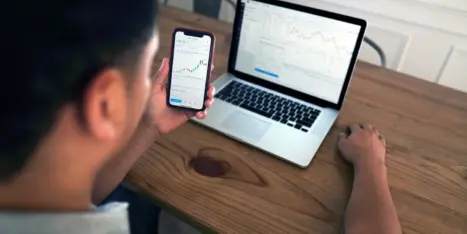You’ve seen the commercials, played with someone’s iPad (less dirty than it sounds, unless you’re doing it right), and used your phone to check in on the Bulls game. But what are we really talking about when we say “touch screen”? Touch screen users access your web content in one of three ways: with a smart phone, with a tablet, or with an app, using either a smart phone or a tablet.
Phones
If you want people to use your site with a phone, you’ll need to create a new version specifically tailored to its smaller screen size and slower connection. Your normal site may work well enough on a smart phone for someone to grab a phone number, but the experience isn’t going to be pleasant. Don’t worry, creating a mobile-optimized site isn’t hard—and the new version should probably be much less extensive than your full-size site.
When building a mobile-optimized site, the first step is determining what users need to do on their phone. The context of mobile use is very important—think “killing time waiting at the doctor’s office” or “trying to find the address of that restaurant” rather than “comparison shopping for a new water heater”. Most sites don’t need more than a few basic pages and an address that links to a map. If you’ve got a blog, make a mobile version to capture the “stuck on a bus” demographic.
Tablets
Apple’s iPad is just the beginning—dozens of competitor tablets are either launching or are set to launch soon. Motorola’s Xoom, available now, is the first true Android tablet (i.e., the first to take full advantage of Google’s mobile operating system, currently the main rival to the iPhone), but it’s very expensive and can’t compete with Apple’s app store. Aimed at the business-minded individual (no real apps), Blackberry’s Playbook will play nice with your Blackberry phone, but it may not arrive until the second quarter of this year; HP’s Touchpad also promises to be a powerful business tool (limited apps), but a similarly late debut risks it being obsolete before arrival.
Are these tablets mobile devices (light and portable) or more like a desktop computer (larger screen, for use in non-mobile settings)? Will people ever really work on tablets? Can we figure out how to keep the screen free of fingerprints? Stay tuned.
Apps
An app is a stand-alone program that runs on either a tablet or a smart phone – and although most apps connect to the web, they are not websites. They have to be downloaded from an app store and then run from the phone or tablet.
Typically, an app is designed to complete a narrow set of tasks, like updating a Facebook page, checking the stock markets, or sending a photo to Flickr. Users love apps because their limited focus—being specifically designed and built for a single task (or group of tasks) to be completed on a single platform—makes them very easy to use. Unfortunately, they’re also expensive to build and aren’t for general use. And once you get yours built and added to the app store, there’s no guarantee anyone will use it: only 5% of free apps are used 30 days after they’ve been downloaded.
So unless your site has an important and focused set of functions that people are likely to use on the go, you probably don’t need an app.




